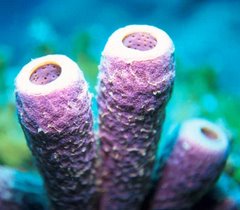
A sea sponge's body primarily consists of spicules and spongin. Spicules are needle shaped fiberlike structures that act as the sponge's skeleton. Spongin is a protein that helps provide body support. In some instances the spongin will combine with the spicules to provied support, in other times the spongin works alone.
 Sea sponges have three different body plans: asconoid, syconoid and leuconoid. Asconoid sponges are tube shaped and perforated by spores. The opening of the tube, called the osculum, leads to the spongocoel, the inner region of the tube. The spongocoel holds the collar cells. Syconoid sponges tend to be larger in size than asconoids and have a tubular body with a single osculum. The syconoid body wall is thicker and the penetrating pores are longer, forming a system of simple canals lined by collar cells. The collar cells' flagella work to force water into the spongocoel and out through the osculum. Leuconoid sea sponges are the largest and most complex. These sponges consist of masses of tissue penetrated by numerous canals, all of which lead to a number of smaller chambers lined with flagellated collar cells. Water moves through the canals, into the chambers, and out through the central canal and osculum.
Sea sponges have three different body plans: asconoid, syconoid and leuconoid. Asconoid sponges are tube shaped and perforated by spores. The opening of the tube, called the osculum, leads to the spongocoel, the inner region of the tube. The spongocoel holds the collar cells. Syconoid sponges tend to be larger in size than asconoids and have a tubular body with a single osculum. The syconoid body wall is thicker and the penetrating pores are longer, forming a system of simple canals lined by collar cells. The collar cells' flagella work to force water into the spongocoel and out through the osculum. Leuconoid sea sponges are the largest and most complex. These sponges consist of masses of tissue penetrated by numerous canals, all of which lead to a number of smaller chambers lined with flagellated collar cells. Water moves through the canals, into the chambers, and out through the central canal and osculum.
THE SKELETON
The "skeleton" of a sea sponge is made up of tiny needlelike splinters called spicules. Spicules consist of a mesh of protein called spongin. Many sea sponges can only be identified by the microscopic examination of the skeleton. Because of this, indentification from photographs can become very difficult.


1 comment:
i really lovd the pic...it ws so awesum..thnk u
Post a Comment